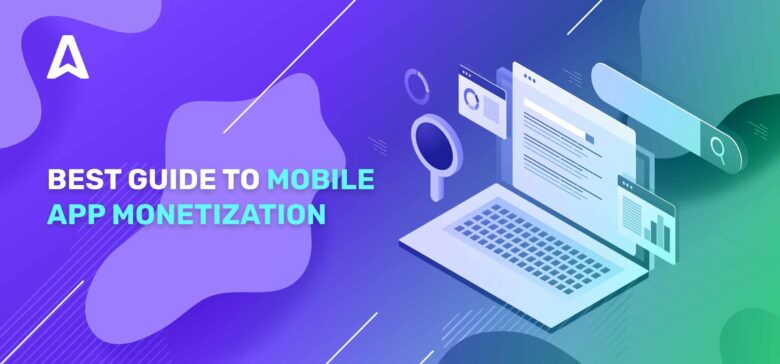Mobile apps are a big business. According to Serpwatch, mobile apps are projected to generate $935 billion in revenue in 2023, compared to $693 billion in 2021 and $365 billion in 2018. These statistics indicate that the mobile app market is huge yet still growing.
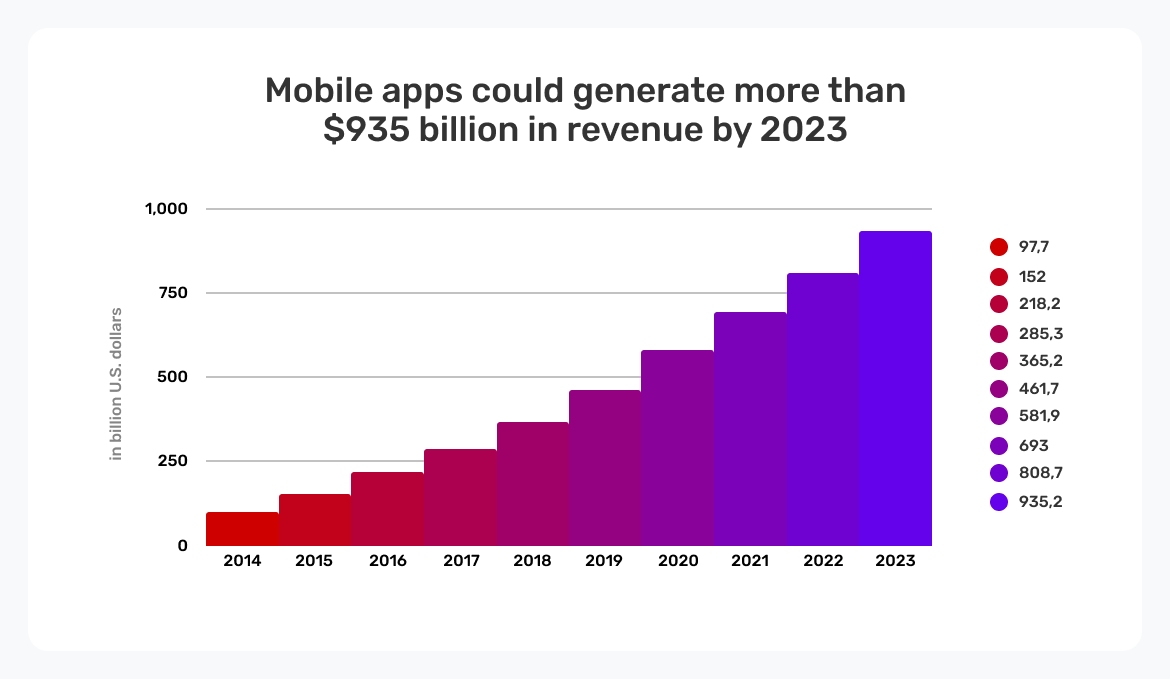
This article will list the best mobile app monetization strategies to help you earn your share of this huge market.
What is app monetization and why is it important?
App monetization is the process of earning money from your app. Apps require considerable money and effort to create, so developers need to recoup their investment and earn profits.
Monetization is crucial because you can’t support your application without it. Any application that doesn’t make money will likely shut down sooner or later, unless it’s a hobby that the developer wishes to fund out of their pockets.
You may find it difficult to implement rich-media ads into your app. You can put a Direct Link, instead. It’s a simple URL you can attach to any text, button, or picture. Join Adsterra and generate an ad code.
Advertisements, subscriptions, and in-app purchases are the most common monetization methods. According to Statista, 36% of global apps incorporate ads to earn revenue.
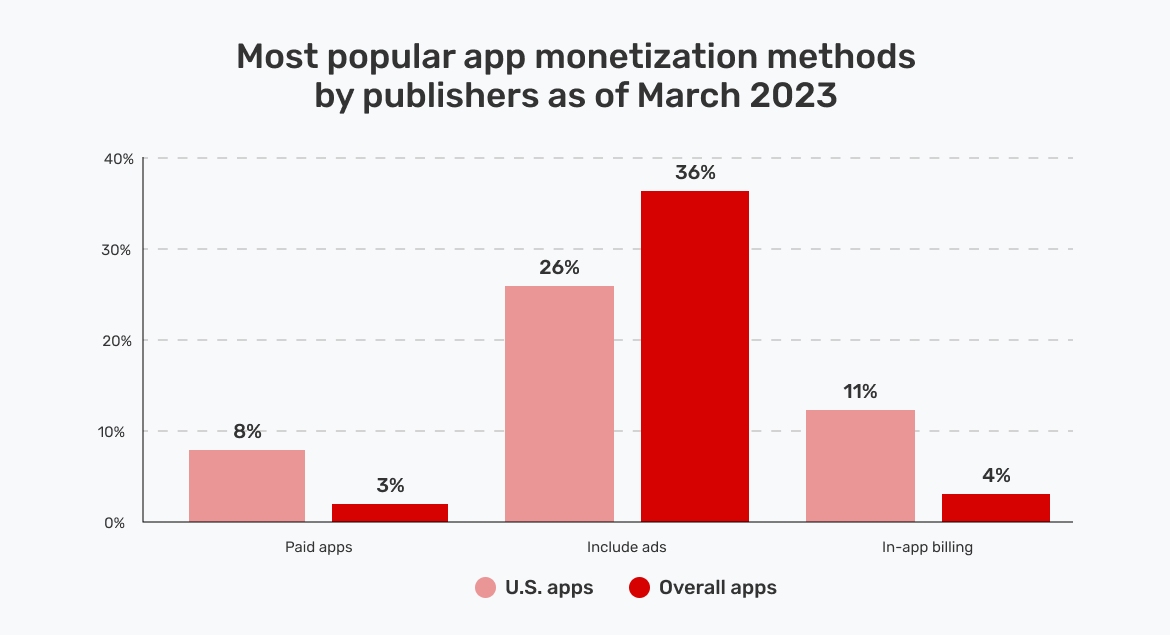
But, there are many other methods, which we’d talk about in this article.
What is the difference between free and paid apps?
Free apps require no payment to download and use, while paid apps require payment before downloading. Free apps tend to receive much more downloads than paid apps because there’s no payment needed, making it easier to amass a large user base. Because of this difference, many developers combine the characteristics of free and paid apps to offer “freemium” apps.
Freemium apps are free to download. But, there are optional in-app purchases for additional content and premium features. Many developers offer a limited number of features for free and demand payment to unlock the rest.
How does app monetization work?
Monetization enables you to convert your application’s users into revenue. It usually includes multiple strategies ranging from banner ads to subscriptions, in-app purchases, and the likes.
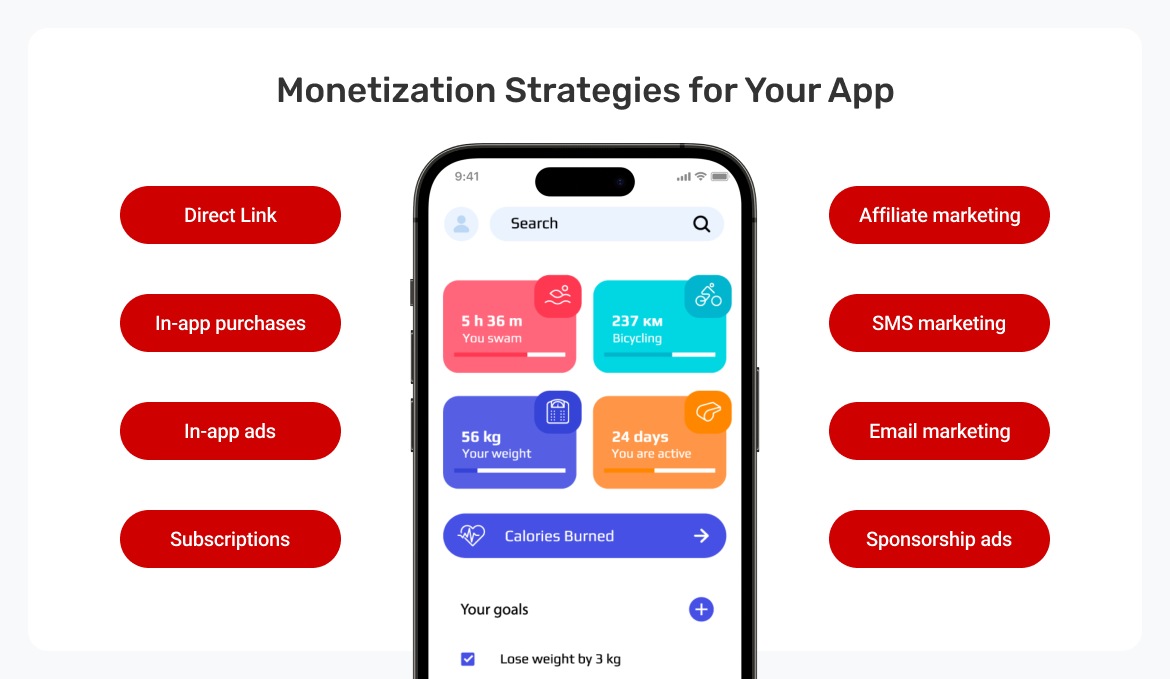
The best strategy to implement depends on the type of application you developed and its user base. For example, gaming apps are known for having in-app purchases, educational apps are known for selling subscriptions, and social media apps primarily run ads to make money.
Some developers focus on one strategy, while others follow a hybrid approach. Either method can yield successful results if implemented correctly.
Before we start
You should not just jump into monetizing your apps without paying attention to some crucial things. For example, have you developed a good content strategy? How often do you update the content on your application? This plays a significant role in attracting new users and retaining existing ones.
You should also pay attention to how you program your application because you may need to customize it extensively as part of your monetization strategy.
- Creating solid code
You should try to write the code for your application from scratch as much as possible. Of course, you’ll need to implement some frameworks, integrations, and existing code libraries, so no app’s code can be 100% original.
But, you should endeavor to be as original as possible because some brands may need you to re-skin your app as part of an advertising campaign. You’ll find it challenging to customize your application if you don’t understand the code.
- Having a good content strategy
Refreshing your app’s content is one of the best ways to convert new or infrequent users into lifelong customers. For example, if you have a game, you should regularly add new levels and challenges to keep users busy. Otherwise, they’ll get bored easily and abandon it.
Similarly, if you run a news platform, ensure to add more content daily. Otherwise, readers will get bored and move to other apps that update more frequently.
App monetization methods
1. Monetize Android apps and APK files with Direct Link
Direct Link is a creative monetization strategy that Adsterra offers for mobile apps and Android APK files. It involves placing a link in your app’s content. Once a user clicks that link, it’ll take them to an advertising page. The advertising page has thousands of ads behind it, and Adsterra’s algorithms determine which ad to show. The algorithm is optimized to show ads with a high cost-per-mille (CPM) and relevant to your audience.
A step-by-step explanation:
- A user opens your app.
- They click on the Direct Link.
- The user is guided to an advertising page.
- You get paid for ad views (CPM) or per suggested action (CPA).
Benefits
- Easy to implement.
- Not distracting to users.
- The algorithm optimizes for higher-paying ads.
You can see Adsterra’s guide for the best practices of working with Direct Links.
2. In-app purchases
In-app purchases imply selling virtual goods and services to users. Let’s say you run a popular first-person shooter mobile game, you can sell virtual ammunition and gear to your users for real money. This model is most popular with games, and many games make millions of dollars from it.

Benefits of in-app purchases
- It fosters engagement. People who have purchased virtual items will likely want to spend time on your app to use it.
- Payment processors such as Apple Pay have made it easy for users to pay for virtual items with a few clicks/taps.
Best practices
- Offer something valuable to your user base, e.g., more virtual cars in a racing game.
- Users who pay for virtual items should not have a big competitive edge over those who don’t. Otherwise, you’ll be labeled a “pay to win” platform.
3. In-app ads
You can advertise for other brands within your platform and earn money each time a user watches an ad or takes a suggested action. This is the most common monetization model and is mostly used by content apps. Even in games, you may find ads alongside in-app purchases.
There are different types of ads, including:
- Interstitial ads
- Native Ads
- Banner ads
Growing your CPM with Interstitial ads
Interstitials are full-screen ads that cover the whole app’s interface. They draw the user’s attention much more than other types of ads, so advertisers are willing to pay more for them.
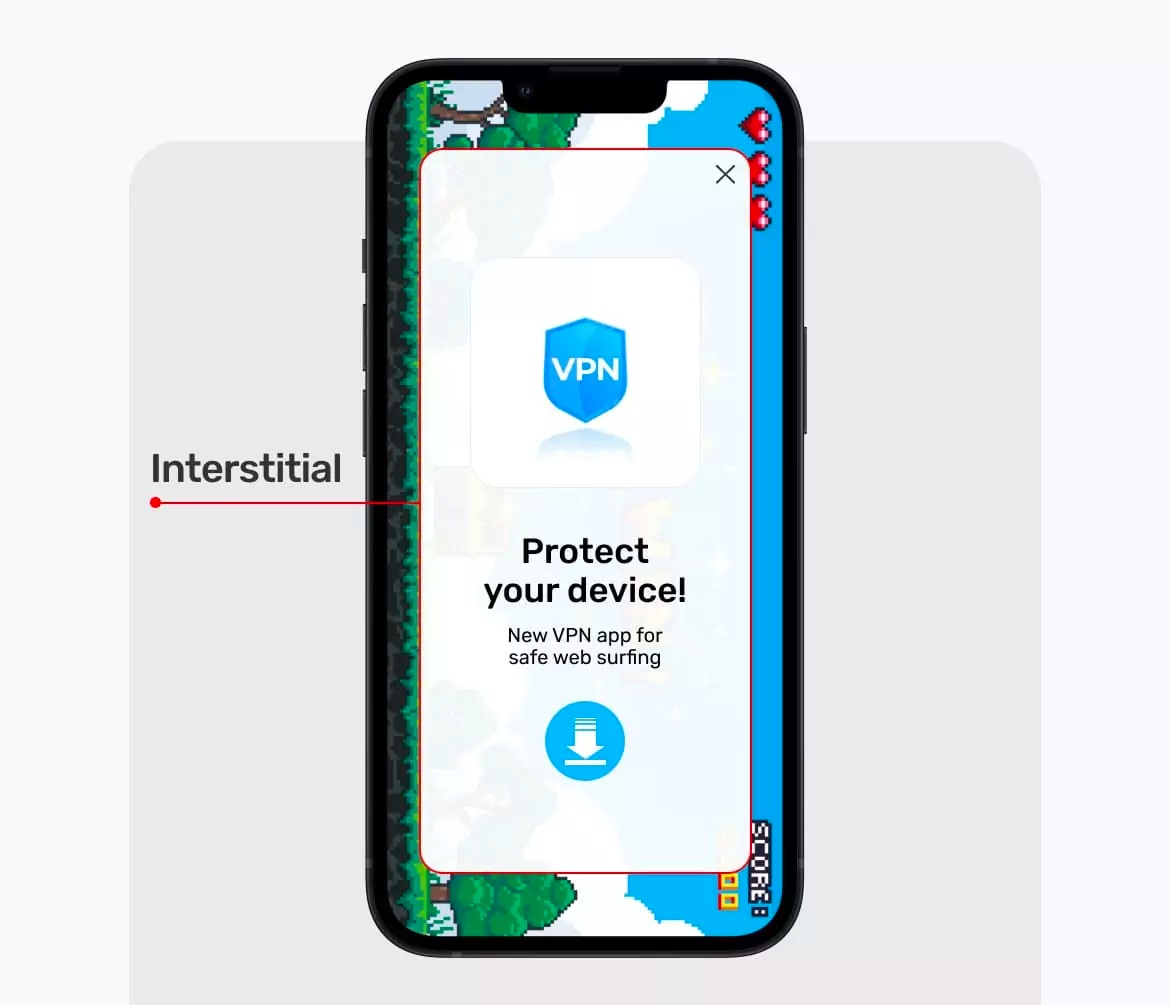
Interstitial ads can help you increase your effective cost-per-mille (eCPM), the amount advertisers pay per thousand impressions.
Improving your click-through rate (CTR) with Native Ads
Native Ads match the look, feel, and function of your application. Some users may not even notice that it is an ad.
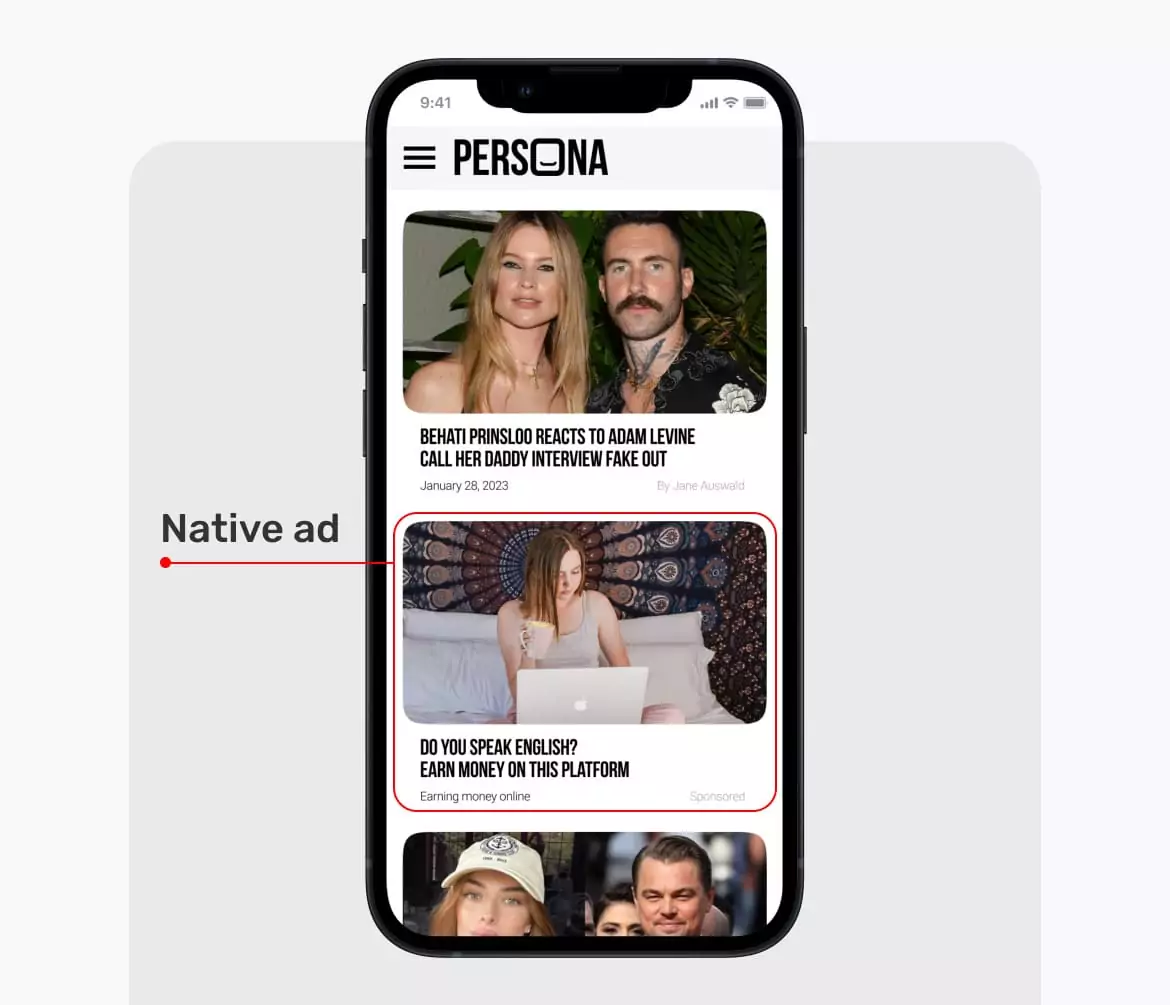
Because of their cohesiveness with your application, native ads tend to get a higher number of clicks than other types of ads. They also enjoy higher credibility with your user base.
Improving your conversion rate with Banner ads
A Banner ad is a graphical display usually appearing at the app’s top or bottom. They can be static or dynamic images with a link attached to them.
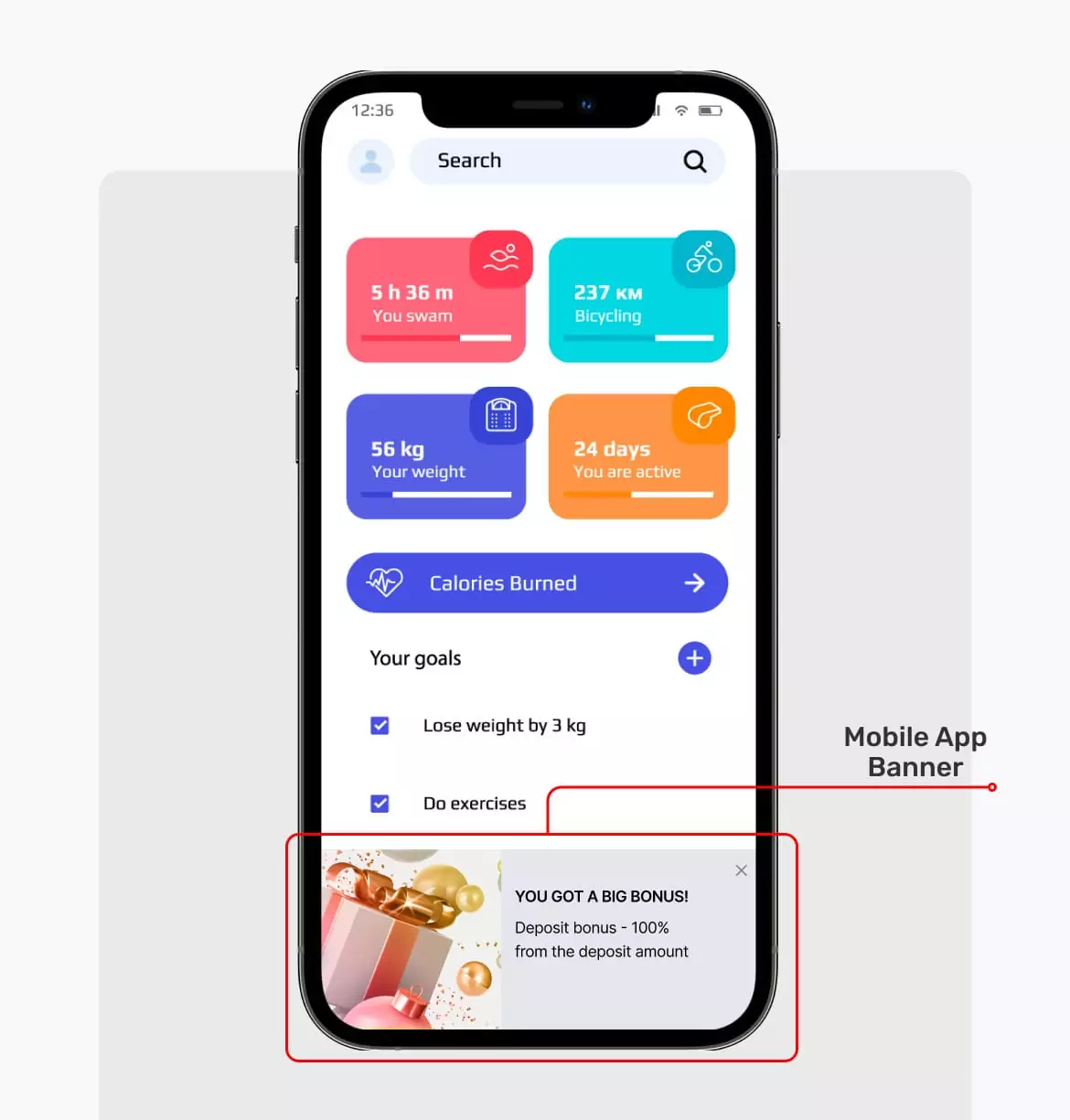
Clicking on the image will redirect the user to the advertiser’s webpage, and you’ll earn money for each click or per thousand views. This is the most common type of advertising and is employed by many popular apps.
Benefits of in-app advertising
- You can insert ads in your application by adding a few lines of code.
- Some ad formats match the look and feel of your platform, so won’t distract the user.
- The mobile ad market is enormous, with brands ever-willing to spend money to showcase themselves.
Best practices for in-app advertising
- Avoid showing too many ads, or you risk annoying users.
- Test different types of ads to see which ones deliver the best results and stick to those ones.
4. Subscription/freemium model
Subscription implies charging users a recurring fee to access your application, usually monthly or annually. Many developers offer their apps for free with limited features and require a subscription to unlock more features. This model is known as “freemium.”
Benefits
- Subscriptions bring in a stable source of revenue. With a specific number of subscribers, you can be sure to earn a certain amount each month or year to support your platform. Compare this to other models where your earnings can easily swing from a high level to a low one.
- It’s easy to predict your future revenue and cash flow by understanding your churn and retention rate.
Best practices
- Subscriptions bring in a stable source of revenue. With a specific number of subscribers, you can be sure to earn a certain amount each month or year to support your platform. Compare this to other models where your earnings can easily swing from a high level to a low one.
- It’s easy to predict your future revenue and cash flow by understanding your churn and retention rate.
5. Affiliate marketing
Affiliate marketing implies promoting a product or service in exchange for commissions. You’ll collect a percentage of every sale originating from a customer referred by your app.
Here’s a step-by-step explanation:
- You sign up on an affiliate marketing platform.
- You find a willing advertiser and generate a unique link for their product. The link will contain a Tracking ID that lets the advertiser know when a referral comes from your platform.
- You place the affiliate link in your app.
- A user clicks the link, goes to the retailer’s site, and purchases the product.
- The retailer pays you an agreed commission on the sale.
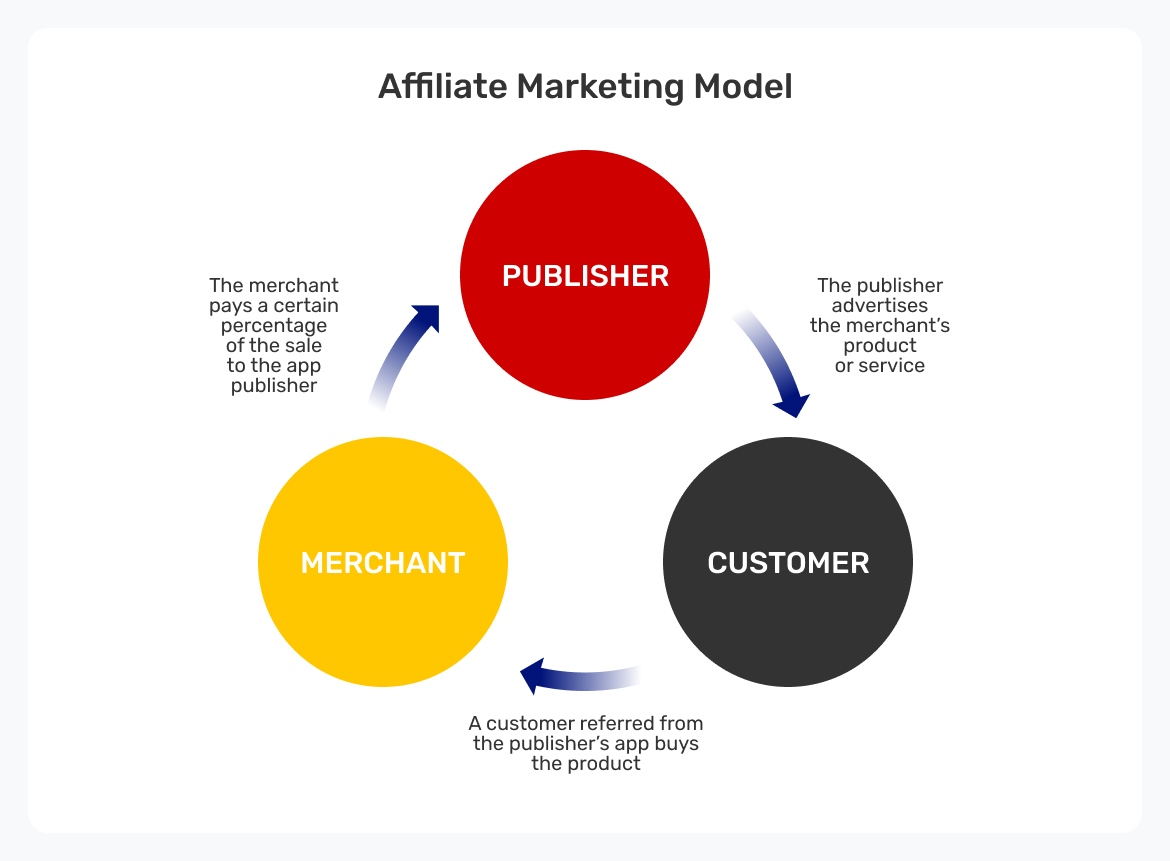
Benefits
- Affiliate marketing is more lucrative than other types of advertising if done correctly.
- A low entry barrier.
- You don’t need much expertise to implement affiliate marketing in your application.
Best practices
- Only promote products that are relevant to your audience. For example, a gaming platform should not post affiliate links for cosmetic products or vice versa.
6. SMS marketing
Many developers overlook SMS marketing as a monetization strategy, but it can be effective. According to SimpleTexting, 60% of users check their SMS notifications within 1-5 minutes.
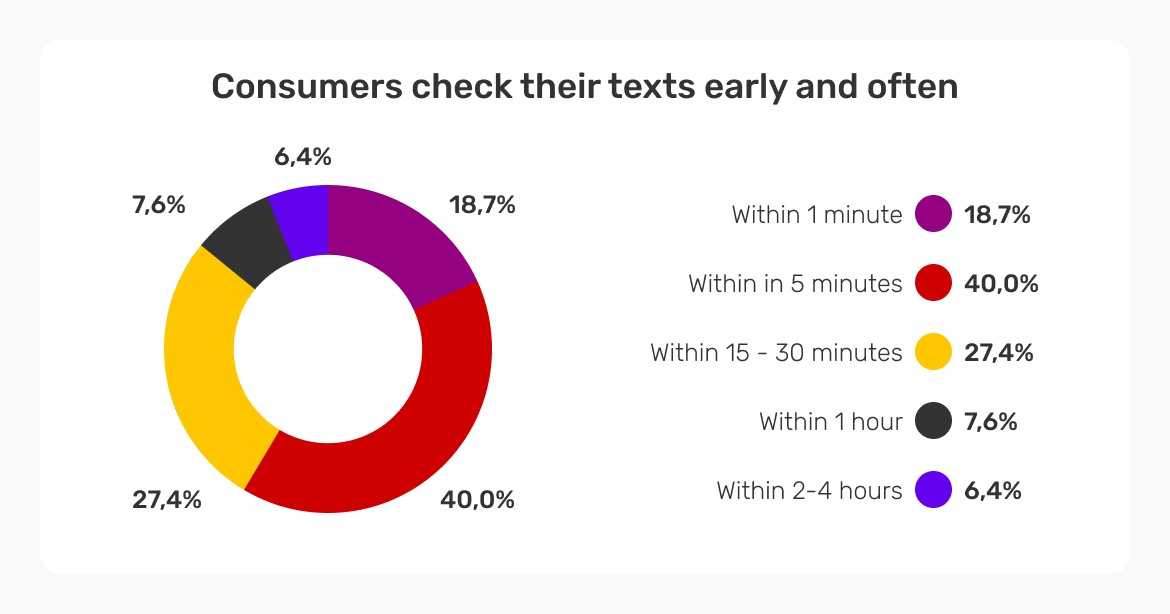
You first need to collect your user’s mobile phone numbers via in-app prompts. Note that you need explicit consent from a user to send marketing messages to them.
After gathering phone numbers, you can send users messages about:
- Application updates.
- Giveaway contests sponsored by other brands.
- Coupon codes and discounts from retail partners, etc.
Benefits
- SMS messages have high open rates, making users more likely to engage with your ad.
Best practices
- Don’t send messages too frequently. That will annoy the user and cause them to block you.
- Obtain explicit permission before sending a marketing message to a user’s phone number. Failure to do so can lead to big fines.
7. Increase engagement with email marketing
Email marketing works similarly to the above SMS marketing process. You can gather users’ email addresses by placing a subscription form in your app. After gathering the addresses, you can send advertising offers to users, such as:
- Discount codes and coupons from retailers.
- Newsletters and blog posts (with display ads included).
- App update announcements.
- Offers from related businesses.
Benefits
- There are over 4 billion active email users, which makes it one of the best platforms to connect with users.
- Emails feel more personalized, making users more likely to engage with your advertisement.
Best practices
- Obtain explicit consent before sending any email to a user’s address.
- Personalize your emails with the user’s details, e.g., “Dear, [Your Name]” at the beginning of the message. This makes the user feel esteemed and more likely to respond to a suggested action.
8. Sponsorship ads (best for large audiences)
Sponsorships are a special type of in-app advertising. It involves selling your entire ad inventory to one or more sponsors for a specific period. This monetization method works best for apps with a large, engaged user base.
Brands are willing to pay top dollar to sponsor an application and showcase themselves to its audience. If your app has a large user base, you may already have brands contacting you for potential sponsorships. Alternatively, you can pitch to relevant brands and let them know what they’ll gain from working with you.
Benefits
- Sponsored ads generate more revenue than typical display ads.
- Advertisements from sponsors bring more stable and predictable revenue than other types of advertising.
Best practices
- Test different types of ad formats to see which ones bring the best results for your sponsors.
- Have a media kit on your website and contact information for potential advertisers to get in touch.
9. Mobile marketing automation
Mobile marketing automation is a process of automating marketing campaigns at scale. It employs software to perform repetitive marketing activities that otherwise would have to be done manually.
A mobile marketing automation campaign will involve collecting data on your users, segmenting users according to that data, and targeting users with ads at specific milestones.
- Collect data: How do users interact with your platform? What amount of time do they spend on it daily? What features do they use most? What previous ad campaigns did they respond to?
- Segmentation: After collecting data, you can separate different user groups according to that data. For example, one group can include users that spend less than 5 minutes on your platform daily, and another group includes people who spend at least 15 minutes daily.
- Targeting: You can target different groups with the ads that’ll be most effective on them.
Benefits
- Mobile marketing monetization takes away a lot of the stress involved in deploying an ad campaign.
Best practices
- You can employ multiple advertising channels, including email, push notifications, in-app displays, etc., to create an integrated marketing campaign.
10. Upgrade to remove ads
A poorly kept secret is that most people do not like advertisements in their apps and will be happy to get rid of them even if it means paying money. Many developers take advantage of this trait and charge users a one-time fee to remove ads from their applications. Once the user pays the fee, they won’t see any ads again. This strategy works well with games where ads may interfere with smooth gameplay.
Benefits
- Users are willing to pay a high price to remove ads from their interface.
Best practices
- To set a fair price for removing ads, calculate the amount an average user generates in ad revenue each year and times that by a multiple of 5.
11. Data-driven strategies
In all, there’s no single best method of monetizing an application. It varies depending on your type of app, its user base, your revenue goals, etc. You need a lot of analytics to determine the best monetization strategy for your application.
Collect accurate data on your user base to determine the best way to monetize your platform. Figure out which users spend the most time and money on your app. In games, this cohort of users are fondly called “whales.” They generate the most revenue, so you should focus more on this cohort than others. They may be a minority but account for most of your revenue.
Data-driven decisions will likely yield more positive results than gut-instinct decisions.
Adsterra offers you one of the most easy-to-integrate ad formats – Direct Link – which uses artificial intelligence to select the ads with the best CPM.
Metrics to measure the success of your app monetization strategy
- Conversion rate: This is the percentage of users that perform a suggested action from an ad, e.g., subscribing or making an in-app purchase.
- Return on investment (ROI): The profit (or loss) generated by the app compared to its development and marketing costs. A positive ROI is when the app generates more than it cost to develop and market.
- Average revenue per user: The amount of revenue generated by each user over a specific period. You calculate it by dividing your total revenue by the number of users.
- Lifetime value (LTV): The estimated amount of revenue a user generates throughout their lifetime on your app.
- Churn rate: The percentage of users that stop using your application within a specific period. A high churn rate indicates that your users aren’t satisfied with what you offer them.
- Retention rate: The percentage of users that continue to use your application over a specific time. A high retention rate indicates that users are satisfied with your service.
- eCPM (effective cost-per-mille): The amount of revenue generated for every thousand ad views within your platform. A high eCPM indicates high ad engagement.
- Ad fill rate: The percentage of ad requests from a server that are successfully filled with an advertisement.
- Click-through rate: The percentage of users that click on an advertisement after viewing it.
Which app monetization tactics should you avoid?
- Intrusive ads: Intrusive advertising is when you show ads that disrupt the user experience, e.g., an unexpected popup when they’re reading an article or auto-play videos within articles. These types of ads can annoy the user and cause them to stop using your application.
- Too many ads: Do not place too many ads on the same page. It can be annoying and discourage the user from continuing to use your application.
- Low-quality ads: Avoid advertisements that promote questionable products or services, e.g., unregulated gambling sites, clickbait, or adware. Such ads can easily break the user’s trust.
- Using too many monetization platforms: Running ads from many ad networks simultaneously can affect your application’s performance. This happens because each network runs its respective ad script, meaning more loading time. Scripts can also interfere with each other and cause your ads not to show.
How to monetize an app — FAQs
The most common way to monetize Android apps is by running advertisements. According to Apptica, 71% of app advertisers chose Android in 2022, leaving just 29% for iOS. This means that subscriptions and in-app purchases are the answers for how to monetize iOS apps.
Android users have been historically more receptive to ads than subscriptions, in-app purchases, and other monetization methods. This happens because there are much more Android devices in existence than iOS devices, and the former tends to be more affordable and common in countries of lower income.
There are many ways to earn revenue from your application outside advertising. You can charge users a recurring fee to retain access to your application or even to download it in the first place. You can sell virtual items and upgrades within your mobile platform for real money. You can also crowdfund donations from users to support your platform, but this model is best suited for open-source applications.
Analytics is the key to choosing the best app monetization models. You can test different strategies to see which ones yield the best results. Did ads or subscriptions generate the most revenue? Did in-app purchases generate more revenue than ads? Etc.
Your type of application also plays an important role. For instance, in-app purchases are best for mobile games, while subscriptions are best for news and content apps.
Subscriptions and in-app purchases are the best ways to monetize an application with a small user base. A small yet loyal audience can earn you significant revenue from subscriptions and purchasing virtual items. In contrast, a small user base will hardly generate much advertising revenue. The key here is to create content that’ll engage and retain your little user base.
Conclusion
You can earn significant revenue from a mobile application regardless of your volume of users. Determining which monetization strategy works best for your platform and implementing it correctly is key. We have explained the main monetization strategies to choose from, their benefits, and key strategies.
Advertising remains the most common app monetization strategy. If you’re searching for an ad network, we recommend Adsterra because it gives you access to a network of over 13,000 high-quality advertisers that pay top dollar for ads.
